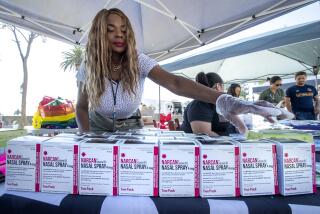Gun Deaths in County Rose 9%, Survey Says
- Share via
The number of firearm deaths in Los Angeles County rose nearly 9% in 2000 over the previous year, fueled by sharp increases in homicides among men and women of all age groups, according to a survey by a gun control group.
Drawing on death certificates and other public records, the survey found that 1,067 county residents lost their lives in firearm homicides, suicides and accidental shootings--averaging more than 20 deaths each week.
Of those, 763 Los Angeles County residents were killed in gun homicides last year. That gave the county a rate of 8.02 such deaths per 100,000 residents, well above the 6.24 national figure.
The data are included in the fourth annual Survey of Gun Deaths in Los Angeles County, which was compiled by Women Against Gun Violence, a statewide coalition of individuals and civic and religious groups. Sheriff Lee Baca and Police Chief Bernard C. Parks sit on its advisory board.
Though law enforcement officials cite increased gang activity, the group’s chairwoman and co-founder, Ann Reiss Lane, said the key factor in the surge of gun violence was the continuing availability of guns.
“From everything we’ve read of the accounts of these deaths, guns are coming from friends and family, as well as through illicit sources. We’re a culture which says guns are OK,” said Lane, a former police commissioner under Los Angeles Mayor Tom Bradley.
Lane said she fears that the Sept. 11 attacks and concerns about terrorism could exacerbate such sentiments, although there is no evidence yet that Californians are purchasing more guns now.
“But we are hearing accounts from other states,” Lane said. “People don’t know what to do. So they buy guns because it feels better to have a gun in hand, even though there’s no evidence terrorism has anything to do with people in their homes.”
Baca too blamed the increasing numbers on the availability of guns, but also the use of those guns by gang members, whom he said account for a disproportionate number of gun-related homicides. In 2000, 46% of all homicides were gang-related, compared with 39% in 1999, he said.
“The problem in high-risk neighborhoods is that even non-gang kids believe they ought to have protection, and get attracted to guns in terms of self-defense, but the self-defense motive can quickly turn into offensive,” Baca said.
The group supports legislation to further restrict the availability of guns and urges more stringent enforcement of gun laws already on the books. But its critics contend that gun control laws in California and especially Los Angeles have had little impact, as evidenced by the increase in gun deaths.
Chuck Michel, a spokesman for the California Rifle and Pistol Assn., said he had not seen the Women Against Violence survey and could not comment on its specifics. But he said the group’s focus is misdirected at taking guns away from law-abiding people instead of the lawbreakers who commit most crime.
“Legally speaking, guns have never been less accessible,” Michel said. “That’s not to say that a black market doesn’t exist, but guns are more controlled, more regulated, more contained than ever.”
The survey found that among Los Angeles County residents 18 and under, gun deaths increased 5.7%, from 141 in 1999 to 149 in 2000. Firearm homicides among youths increased from 124 in 1999 to 134 in 2000.
Sixteen children 14 and under died by gun in 2000 and all of the deaths were homicides. In two cases, the children were shot and killed by parents who then committed suicide.
Gun-related homicides overall increased by 16.7% after declining 7.9% in 1999. Homicides represented nearly 72% of all gun deaths in 2000. Eighty-eight women died in gun homicides in 2000, up nearly 13% from the previous year, while homicides among men numbered 676, up 17.4%.
The numbers do not give voice to the human toll. Those who lost their lives included a cook, a bodyguard, a florist, an oil driller, a rapper, a termite inspector, a studio grip, an X-ray technician and a 19-year-old cable installer named Timothy Jackson Orange, a Lancaster resident who loved football, wanted to study to become an electrical engineer and was about to marry his high school sweetheart.
Those dreams were shattered one Sunday morning after Orange left church and went to visit a buddy. Sitting on a couch in his friend’s apartment, Orange was confronted by a stranger who appeared drunk and asked if he were a gang member. After Orange replied negatively, the man pulled a gun from his pocket and shot him at point-blank range.
For his death, his family grieves, but they also question its senselessness and the role played in it by the readily available handgun. It emerged at his trial that the assailant had purchased the gun from a friend in Michigan.
“We weren’t able to find the gun used in the crime, it was never recovered and could be out there ready to use again,” said Timothy’s mother, Tonie Orange. “Penalties need to be stiffened, loopholes need to be closed, we have to crack down on dirty gun dealers. If we really put an effort into being safer I really believe we can save our youth.”
More to Read
Sign up for Essential California
The most important California stories and recommendations in your inbox every morning.
You may occasionally receive promotional content from the Los Angeles Times.











